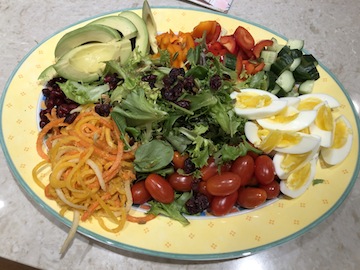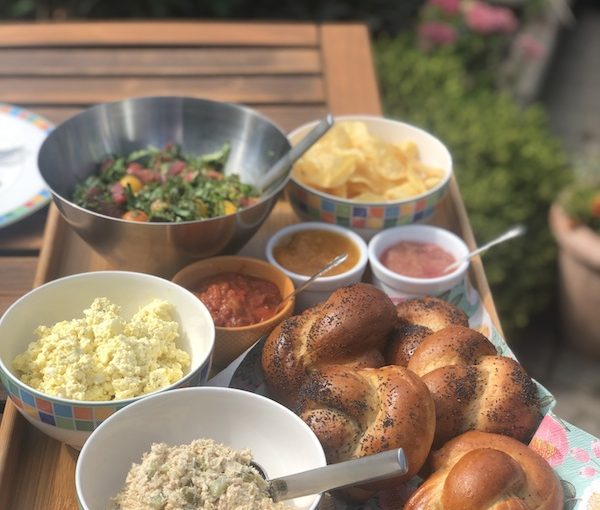Planning ahead can help minimize touch points and help keep a small gathering safe. (photo by Michelle Dodek)
We all remember the days when we gathered family, friends and maybe some strangers together at our holiday table to celebrate Rosh Hashanah. For me, it feels like a distant memory but I know I loved preparing loads of food for all of us to enjoy together. And I’m looking forward to doing it again this year, albeit outside, under cover of a tent my brother luckily bought before his eldest daughter’s bat mitzvah (and has subsequently used for the bat mitzvah parties of his two younger daughters and other gatherings, particularly since COVID hit).
Dinner in my family has always a “family style” affair, where dishes are passed from one to the next and then left on the table for anyone to help themselves to seconds or thirds. Lunch on the first day of Rosh Hashanah, which is the main event in my home (aka “the Big Lunch”), has been, for the more than 20 years I’ve hosted it, a giant buffet.
For some people, reverting back to the way things were may be an easy mental step. For others, in an environment with unvaccinated children, immunocompromised loved ones and a newfound awareness about germ transmission, things will not go back to the way they were pre-pandemic. Not yet, given the latest mask mandate, and maybe not ever.
What to serve and how to serve it has always been a challenge in my family. How do we make sure everyone is comfortable with the food choices and the way they are presented? We have a few parameters since we are kosher and have those with nut allergies, dairy sensitivities, oral allergy syndrome, a few vegetarians and others who are just plain particular. Inviting upwards of 40 people, usually closer to 75, always presents some logistical fun, especially with environmental concerns ruling out disposables. All of these challenges have created an environment where thinking creatively about food is a necessity. My formal training as a chef has helped with this process.
The two parts to making sure your guests are at ease this holiday season are choosing a delicious menu (as usual) and presenting the food in a way that features as few touch points as possible. Menus can go one of two ways: traditional or modern. For traditional foods, I will defer to your family’s minhag (tradition). Some families and cooks take great pleasure in their annual interaction with time-honoured recipes. I treasure my baba’s potato knish recipe and relish the prospect of circling my challah and topping it with another small, braided crown the way my mom showed me when I was a little girl.
As a vegetarian, however, I have never presented a full array of traditional Ashkenazi foods to celebrate any holiday. Pickled tongue? Not a chance. In fact, I felt like a bit of a bad Jewish mother when my daughter was 5 years old and leaned over to me at my mother’s yontif table as the soup was served and whispered, “Chicken in soup! Weird!” My soups are seasonal, bright vegetable soups like butternut squash or carrot ginger.

The farmers market produce that looks most appealing is what guides my menu. I feel strongly that bringing the bounty of our local harvest to my celebration of a spiritual new year is integral to our connection with where we are and how we live. That topic, however, is for another article.
Let me suggest, if you wish to bring your offerings into 2021 and still have your food choices reflect the symbolism of our tradition, try a couple of approaches.
First, look to Israeli cuisine. The mash-up of all Jewish traditions from Austria to Addis Ababa give many tasty options that will become new staples at your family gatherings.
Second, many Sephardi foods focus on beautiful vegetables and fruits that were not available to people living in Eastern Europe. However, living as we do today, we have access to almost every possible kind of produce. Invest in a few good cookbooks, like those of Adina Sussman, Jana Gur, Einat Admony or Yotam Ottolenghi for ideas on how to up your game with some vegetable forward, delicious, holiday-worthy food.
As far as ways to serve your food, here are some options to consider in order to be considerate of your guests in this special year of our emergence from pandemic holiday isolation.
Option 1: “Modified Family Style aka Downton Abbey,” using family members as the serving staff. For this option, the cook enlists the help of a few willing family members, (in my case, my teenaged children, my sisters and my brother). Each helper is given the responsibility to serve a dish, going from guest to guest, giving a description of the delicacy and spooning out an appropriate amount. While efficient, this does lend itself to the possibility of green bean almandine on Bubbie’s shoulder or salad in Grandpa’s lap.
Option 2: “Plated Dinner aka Eat What’s On Your Plate aka Sweat Away, Host.” This is the restaurant-style plate that hasn’t been so common at home since the Starbucks revolution in dining, where everyone has to have everything their way. In this model, everyone gets the same thing, in approximately the same amounts. Similar to a restaurant but without choosing your order. This results in more food waste, because, although it hasn’t been dropped on Grandpa’s lap, some of dinner will no doubt be pushed to the perimeter of the plate and left for the compost. It also requires, as suggested in the third version of the name, for someone to toil in the kitchen to make every plate and be on call if someone wants seconds of quinoa pilaf and doesn’t have the good fortune of sitting next to a toddler who has pushed all of that mixed grain thing to the edge of her plate. One can enlist the help of volunteers to assist with the plating to speed things up and, most certainly, some people will be needed to take the finished plates to the table, but the onus of refills will almost certainly fall to the person in charge of the kitchen.
Option 3: “Staffed Buffet” is probably the easiest, depending on the set up of your house. In this iteration of food service, a couple of people serve the buffet of food to the guests as they walk by with their plates. This eliminates having everyone touch the serving utensils. It requires fewer helpers than Option 1 and is more customized than Option 2. The catch is that your house needs to be set up to accommodate a group of hungry Jews traipsing along – and staying patient long enough with their family members who are acting as servers – to get all of their food. One major recommendation is, to avoid a stampede or major butting in line, do not serve any version of smoked salmon. For some reason, the sight of thinly sliced orange fish causes many Jewish people to act like Americans at Walmart on Black Friday.
Good luck with your holiday entertaining. Keeping things small this year to ease back into the intimacy of entertaining is also probably a great idea. Remember to say a hearty Shehechiyanu with your assembled guests for, if the pandemic has taught us one lesson, it is never to take being with our loved ones for granted. Shana tova.
Michelle Dodek is a longtime contributor to the Jewish Independent and a balabusta. She shares her love of cooking and entertaining through culinary classes, both in person and on Zoom.

